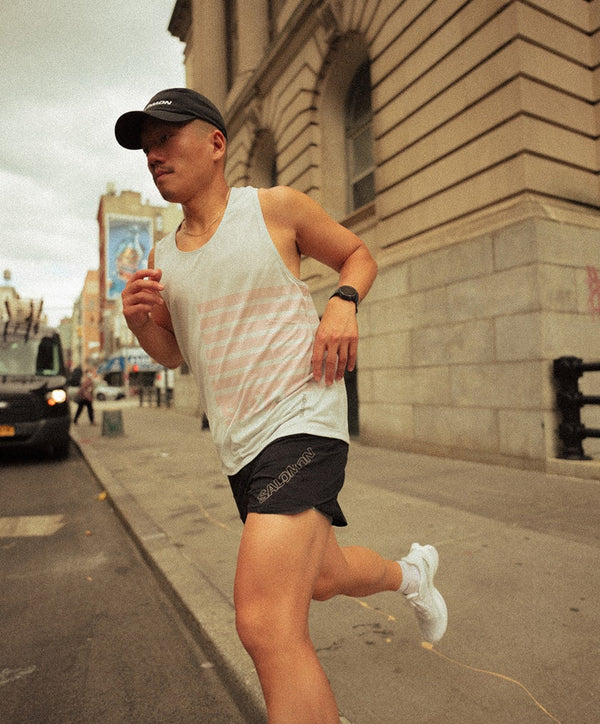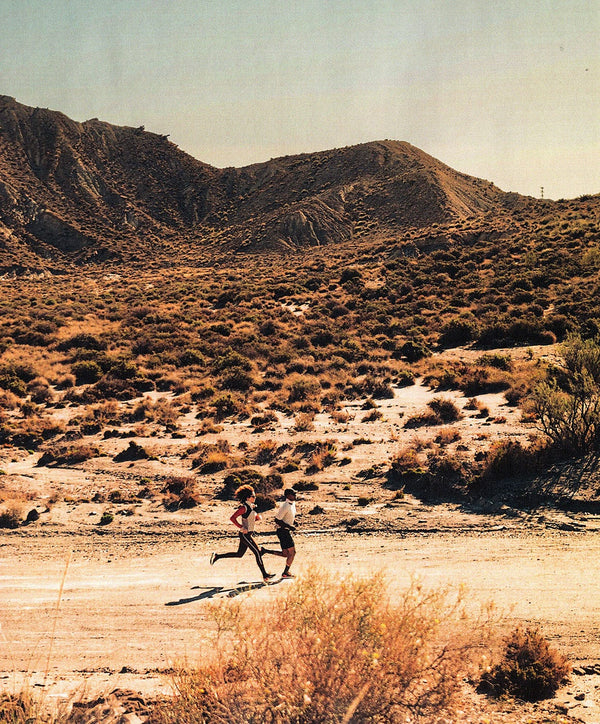Road running conjures images of navigating the cityscape—pounding the pavement, traversing busy streets, and weaving through sidewalks in the "concrete jungle," one stride at a time. Trail running, on the other hand, takes you off the beaten path, through rugged terrain, rocky trails, dense forests, and steep mountain ridges. But what about the runs that blend both worlds? The ones where you cover a few kilometers on asphalt before hitting the dusty trails of your local park?
We call this new hybrid experience gravel, gravel running, or GRVL.
Gravel is a natural progression from road, but not a leap to trail.
DAVID JOU: FINDING VERSATILITY IN GRAVEL RUNNING
David Jou is a physical therapist, co-founder, and brand director at Motiv NY. He specializes in manual medicine, endurance athletics, and outdoor programming. Living in New York, he shares his experience of running in the big city and his efforts to bring variety to his runs.
What is gravel running to you?
As an urban dweller who trains primarily on the road and an ultrarunner who prefers the technicality of upstate terrain, gravel running provides the versatility I’m looking for. It's engaging and an effective way to add variety and cross-training into my routine, not to mention how much it benefits my joints! Unlike trail or road running, gravel running is soft, natural, inviting, safe, and even restorative. Words like fast, hard, long, and steep don’t quite capture the essence of gravel running, which is why I think it draws runners in. Also, running can often evoke a competitive spirit, but on gravel, this becomes less of a motivator. The mindset shifts from competition to discovery, exploration, adventure, and fun.
Gravel running is characterized by its adventurous and exploratory attitude, taking place on varied, natural, and often unpredictable terrains. It demands adaptability and self-sufficiency from runners. In contrast, road running is associated with performance, consistency, and is considerably more accessible.
In NYC, you’d be surprised by the dirt and bridle path systems available in our parks. When I finally discovered them a few years ago, I found other runners also looking to mix it up. In contrast to what road offers, running on gravel allows runners to dabble and experience unique and interesting surfaces, but doesn’t force them to commit to a sport like trail running. It's a natural progression from road but not a leap to trail.
What is the gravel community like?
Gravel running communities are rooted in adventure, exploration, and camaraderie. They prefer the unpredictability of natural terrain and value the experience over speed or competition. Gravel runners are prepared for anything, equipped with the right gear and fuel to handle whatever the day throws at them. It's a tight-knit, supportive group that values fellowship and accountability. They're adaptable and resilient, ready to tackle any conditions with a positive, adventurous spirit.
Community fosters social connections, the sharing of knowledge, and provides motivation. For the sport of gravel running, it offers a way to organize meet-ups, allowing runners to train and race together while exploring the outdoors. It turns what can be an isolating sport into one that is more social, accessible, and enjoyable.


CHRISTIAN MEIER: FROM ROAD BIKING TO GRAVEL RUNNING
Christian Meier is a Salomon runner from Canada. Between 2008 and 2015, he frequently made the podium at the Canadian Road Biking Championship and competed in World Championships and The Classics in Europe. He is the co-founder of “Overland Running Provisions,” a running crew and concept store in Girona, Spain, as well as “La Fabrica,” a bike and coffee shop.
What is gravel running to you?
Gravel running is hard to define because it varies for each person. Personally, I push gravel running to the extreme, testing my limits to see how far I can go. For many, it's more about getting off the roads, especially in the US, Australia, and parts of Europe. If you're not competitive, gravel running is very appealing—it's safer and more accessible. Girona is a small, quiet town in Catalonia, without much hustle and bustle. The Pyrenees offer super technical terrains, but we also have easily accessible, flat trails that are flowy and not too technical. This makes them perfect for gravel running and explains why it has become so popular here. People want to spend time outside, and once you get a taste of the outdoors, you want to keep coming back!
Through our shop, Overland, we spent a lot of time developing a community, bringing people together on runs and other activities, mixing up locals and expats. The city has evolved into an international community of people looking for an active lifestyle.
The Pyrenees offer super technical terrains, but we also have easily accessible, flat trails that are flowy and not too technical, which is great for gravel running!
How does one transition from road running to gravel running?
Transitioning from road running to gravel running is basically like using the same type of shoes but with bigger tires! This gives you the confidence to start running on easy, flowy trails. The shift from road to gravel is probably less defined than the shift from gravel to trail. Many people who run on the road already incorporate gravel into their routes, looking for variety in their runs, and naturally end up running on park trails.
For me, road running feels more serious, especially when training for a marathon. I don’t necessarily think about going running on the road for fun or to clear my mind, I would probably do that on gravel, which to me is all about the vibe: cruising along, stopping to take photos or at a café… Just enjoying the outdoors and being with people.


GUILLAUME SANCHEZ: MICHELIN-STARRED CHEF, FOUNDER OF NESO PARIS, AND SALOMON AMBASSADOR
What makes gravel different from road running?
To me, gravel running stands out because of its flexibility. I see my runs as fun rather than training. For most runners, running doesn’t have to feel like a job or a task; it can be a way to disconnect and enjoy the moment. The right pair of shoes can make this experience more intuitive because you don’t have to worry about choosing the perfect footwear for your run. That’s what makes gravel running different!
What makes gravel special according to you?
I like to run, but most of all, I like to have fun while running, which is why I dislike easy pace runs but love signing up for races. It took me years to break the routines that defined my life, and gravel running feels like a way to break the routines and habits of amateur running. It’s about more freedom and less hassle.


JULIEN BOTAS: DRUMS AND RUNS
What makes gravel different from road running?
There isn’t just one type of terrain with gravel running, nor is there one specific style. I like to decide at any moment if I want to run on concrete, along the side of the road, or take a turn and hit a trail. I just love feeling free, with no preparation and no set path. I just put my shoes on and go wherever my legs take me.
What is the mindset of gravel communities?
Gravel communities are about sharing the joy of running without the constraints of distance or terrain—they just want to run together! It’s so important to have a community because that’s how we share experiences: being able to chat and exchange opinions on runs without worrying about pace or anything else. That’s the freedom we’re looking for!


EMBRACING THE GRAVEL SPIRIT
Gravel running offers a unique blend of freedom, versatility, and exploration that appeals to runners of all levels. Whether you’re looking to break free from the routine of road running or enjoy a less technical version of trail running, gravel provides a perfect balance. It’s about the joy of discovery, the thrill of varied terrains, and the camaraderie of a community that values the journey as much as the destination. With the right gear, you can seamlessly switch between surfaces and focus on what truly matters: enjoying your run.









